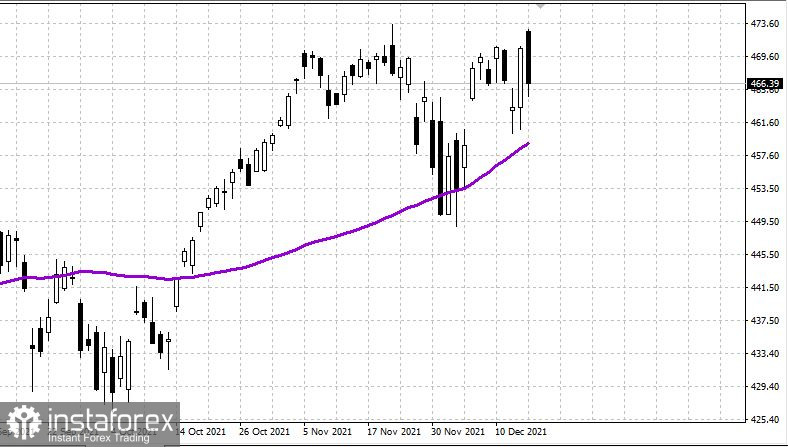
S&P500
The US market has fallen from the highs of the year.
The major US market index rose on Thursday, hitting a high of the year, but then fell by the close. On Thursday, the Dow lost 0.1%, the NASDAQ dropped by 2.5%, and the S&P500 was down by 0.9%.
Asian markets closed the week lower on Friday morning. Japan's indices dropped by 1.9%, while China's indices lost 1.3%.
Oil is trading in the $72-$77 range. Brent crude is falling moderately on Friday.
Gas prices in Europe have again risen to record levels of $1,600 per thousand cubic metres. Such prices were seen at the start of the gas crisis in October. The ECB has sharply increased its inflation forecast for the EU from +1.7% to +3.2% for 2022 amid a surge in gas and gas-related electricity prices.
The number of coronavirus cases worldwide keeps rising. Yesterday, there were 723,000 new cases around the world. In the US, there were 145,000 cases. The UK saw an increase of 88,000. France and Germany reported 60,000 and 53,000 new infections respectively.
The S&P500 index is trading at 4,669 and is expected to be in the 4,630–4,700 range. On Thursday, technology stocks fell most of all. The NASDAQ index dropped by 2.5%. Stocks in the Dow index barely declined. They became a safe haven for investors. Thursday's drop marked a delayed market reaction to the Fed's rate tightening announced on Wednesday. Investors also saw a good opportunity get out of the market at the highest of the year. On Thursday the Bank of England unexpectedly raised its rate by 0.25% for the markets. The reason was high inflation. At the same time, the ECB said yesterday that it will cut its growth support programme but will not give up its growth support. Notably, the Fed announced on Wednesday that it is accelerating the winding down of its programme of injections into the economy. The support programme will now be cut at a rate of $30bn a month and completed by April 2022. According to Wall Street experts, this provides an opportunity for the Fed to raise interest rates as early as 2022. The reason is that inflation was 6.8% in November. Inflation, in turn, has reached such heights as a result of huge injections into the economy both from the Fed and huge support packages for the economy, businesses and citizens from the US administration.
Despite a universal fight against global warming and a transition to green energy, reports show that 2021 will be the record year for coal-fired power generation in all years. The amount of electricity generated from coal power plants has soared by 9% this year. In India and China, the increases were 9% and 12%, respectively. In the US and the EU, coal power generation rose by 20%. One of the reasons for the rise in coal use is the sharp rise in global gas prices in 2021. The IEA expects record global coal demand in 2022. Demand is expected to grow by 6% over the current year and production will rise by 4.5%. Still, so far total coal demand has not exceeded the highs of 2013 and 2014.
The US Congress approved raising the federal government's debt limit by $2.5 trillion, to about $31.4 trillion. President Joe Biden also signed it.
Reports yesterday showed that jobless claims rose by 206K for the week. Long-term unemployment fell by another 150K for the week to 1.850m. The US property market boom continues. New home starts climbed to 1,679K in November.
USDX is trading at 95.90 and is expected to be in the 95.60–96.20 range. The dollar index declined yesterday amid a sharp rise in the British pound after the Bank of England's rate hike and a rise in the euro against the dollar. This happened as the market was probably preparing for tougher announcements from the Fed on Wednesday.
USDCAD is trading at 1.2790 and is expected to be in the 1.2700–1.2860 range. The pair has moved into range and is waiting for impulses from the dollar or from oil prices.
The situation in the US market before Christmas will be less and less predictable. Both new upward attempts and new strong sell-offs are possible. Large investors will only buy after new strong market declines.





















